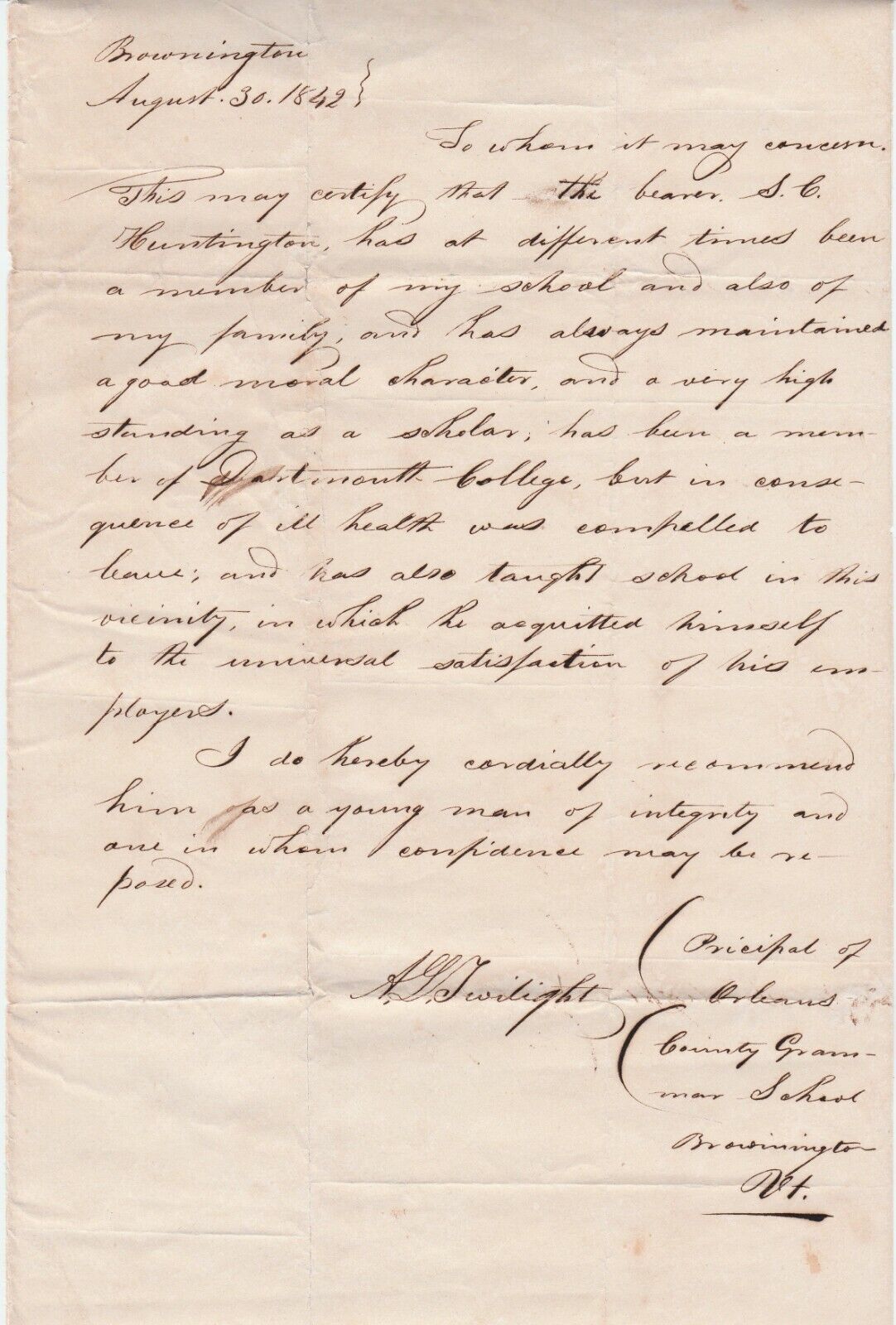|

On eBay Now...
1st Black American College Grad - Alexander Twilight Signed Letter 1842 - x RARE For Sale

When you click on links to various merchants on this site and make a purchase, this can result in this site earning a commission. Affiliate programs and affiliations include, but are not limited to, the eBay Partner Network.

1st Black American College Grad - Alexander Twilight Signed Letter 1842 - x RARE:
$45000.00
EXTREMELY RARE- Original Signed LETTER
First African American College Graduate
& First African American LegislatorAlexander TwilightAutograph Signed Letter
1842
For offer, a very rare old letter! Fresh from an old prominent estate. Never offered on the market until now. Vintage, Old, Original - NOTa Reproduction - Guaranteed !!
To my knowledge, no letters or other items of Alexander Twilight have ever been offered on the market, making this extremely rare. This letter was discovered in a collection of personal letters of lawyer Sylvanus C. Huntington who was District attorney of Oswego County, NY in the late 19th century. He studied with Alexander Twilight in the 1820s (verified by records at the grammar school in Vermont), and went on to study at Dartmouth and tutor President Andrew Jackson\'s family after becoming a teacher himself. Autograph letter signed, entirely in the hand of Alexander Twilight. Letter of reference for Mr. S.C. Huntington. 4 pgs. [1 ms. pg, 3 blank pages]. Twilight signed the letter as Principal of the Orleans County Grammar School, Brownington, Vermont. Dated August 30, 1842. Alexander Lucius Twilight (September 23, 1795 – June 19, 1857) was an American educator, minister and politician. He is the first African-American man known to have earned a bachelor\'s degree from an American college or university, graduating from Middlebury College in 1823. He was ordained as a Congregational minister and worked in education and ministry all his career. In 1829 Twilight became principal of the Orleans County Grammar School. There he designed and built Athenian Hall, the first granite public building in the state of Vermont. In 1836 he was the first African American elected as a state legislator, serving in the Vermont House of Representatives; he was also the only African American ever elected to a state legislature before the Civil War. See below for more. ALS is in good to very good condition. Found folded up, so normal fold marks present. Professional, light acid free archival repair on back, as the letter was ripped. First page starting to separate at bottom from cover page. Please see photos and scans for all details and condition. NOTE: the portrait of Twilight is not included here, and is for reference only.If you collect19thcentury Americana history, American manuscript handwriting, African Americans of note, etc.this is a nice one for your paper or ephemera collection. Genealogy research importance as well. You will never see another one like this! 2401
Alexander Lucius Twilight (September 23, 1795 – June 19, 1857) was an American educator, minister and politician. He is the first African-American man known to have earned a bachelor\'s degree from an American college or university, graduating from Middlebury College in 1823. He was ordained as a Congregational minister and worked in education and ministry all his career. In 1829 Twilight became principal of the Orleans County Grammar School. There he designed and built Athenian Hall, the first granite public building in the state of Vermont. In 1836 he was the first African American elected as a state legislator, serving in the Vermont House of Representatives; he was also the only African American ever elected to a state legislature before the Civil War.
His house and Athenian Hall are included in the Brownington Village Historic District, listed on the National Register of Historic Places (NRHP).
African-American rootsAlexander\'s father, Ichabod, was born in Boston, July 1765. Ichabod\'s father was black, his mother, white, possibly an indentured servant. Eventually, Ichabod married Mary, described as \'white\' or \'light-skinned,\' implying she was of partial African descent.[1]
Early life and educationAlexander Lucius Twilight was born September 23, 1795, in Bradford, Vermont.[1][4]
Starting around 1802 when he was eight years old, Twilight worked for a neighboring farmer in Corinth.[2] Working from an early age was typical of working-class children of his era.[2] For the next 12 years he read, studied, and learned mathematics while working in various farm labor positions.[2]
Twilight enrolled in Randolph\'s Orange County Grammar School in 1815 at the age of 20.[2] From 1815 to 1821, he completed all the institution\'s secondary school courses as well as the first two years of a college-level curriculum.[2] He enrolled in Middlebury College in 1821, where he graduated in 1823 with a bachelor of arts degree.[2] He was the first known African American to receive a degree from an American institution of higher learning.[2] This did not become widely known until 1826, when Amherst College awarded a bachelor\'s degree to Edward Jones and claimed that he was the first African-American college graduate, which prompted Middlebury College to publicize Twilight\'s earlier graduation.[5]
CareerHis first job was teaching in Peru, New York.[2] Twilight also studied for the ministry with the Congregational Church and served several Congregational churches.[3] He occasionally led worship services and delivered sermons.[2] The Champlain Presbytery of Plattsburgh licensed him to preach.[2] Twilight taught for four years in Peru, then moved to Vergennes, Vermont, in 1828 to teach during the week and hold weekend church services in Waltham and Ferrisburg.[2]
In 1829 Twilight was hired as principal of the Orleans County, Vermont, Grammar School in Brownington, the only secondary school in a two-county area,[2] where he was also ordained as minister of the Congregational Church.[2] He built a house for his family shortly after arrival, which still stands and is the headquarters of the Orleans County Historical Society.[6]
Photo of the Old Stone House, Brownington, Vermont.Athenian Hall, now better known as The Old Stone HouseWanting to create a residence dormitory to accommodate out of town students, from 1834 to 1836, Twilight designed, raised funds for, and had built a massive four-story granite building which he called Athenian Hall.[2] The first granite public building in Vermont,[3] it served as a dormitory for the co-educational school, also known as the Brownington Academy.[2] Both his home and Athenian Hall are today part of a historic district listed on the National Register of Historic Places.[3][7]
In 1836, Twilight was elected to the Vermont House of Representatives, becoming the first African American to be elected to a state legislature.[2] As a member of the House, he worked unsuccessfully to persuade the Vermont General Assembly not to divide school funding between Brownington and nearby Craftsbury, which had decided to open its own school.[2]
He left his job as headmaster in 1847, apparently after a falling out with the Brownington school\'s trustees.[2] He taught school in Shipton and Hatley, Quebec.[2] Without Twilight\'s leadership, the school in Brownington experienced declining enrollment, and it was closed in 1852.[2] Persuaded to return to Brownington, Twilight resumed his duties as principal and pastor.[2] He resigned as pastor in 1853, and continued as principal until 1855.[2]
Death and burialIn October, 1855 Twilight suffered a stroke which left him partially paralyzed and caused him to retire as principal of the Brownington school.[2] He died on June 19, 1857, and was buried at the Congregational church in Brownington.[3]
Marriage and familyIn 1826, Twilight married Mercy Ladd Merrill of Unity, New Hampshire.[3] They remained married until his death, and had no children. Mercy Twilight died in 1878.
Legacy and honors
Alexander Twilight Hall at Middlebury CollegeAlexander Twilight House (1830), still stands across the street from Athenian Hall. Today it serves as headquarters for the Orleans County Historical Society. It is within the Historic District listed on the National Register of Historic Places (NRHP).Athenian Hall (1834–36) is now operated by the Orleans County Historical Society as the Old Stone House Museum, and anchors the Historic District of Brownington. It was the first granite public building in Vermont.[3]Alexander Twilight Hall at his alma mater Middlebury College was named in his honor.The Alexander Twilight Auditorium at Lyndon State College is named for Twilight.The Aspire Alexander Twilight College Preparatory Academy in Sacramento, California, was named for Twilight. It opened in the fall of 2009.[8]The Twilight Awards, a special awards show to celebrate teachers, schools and education nonprofits were named for Twilight.[9]Howard Frank Mosher wrote about the Stone House in Vermont Life Magazine, Autumn 1996:I like the way the Stone House still looms up on that hilltop, where the wind blows all the time. There it sits, unshaken and monolithic, as I write this sentence and as you read it, every bit as astonishing today as the day it was completed. What a tribute to the faith of its creator, the Reverend Alexander Twilight: scholar, husband, teacher, preacher, legislator, father-away-from-home to nearly 3,000 boys and girls, an African American and a Vermonter of great vision, whose remains today lie buried in the church-yard just up the maple-lined dirt road from his granite school, in what surely was, and still is, one of the last best places anywhere.
SYLVANUS C. HUNTINGTON
Judge HUNTINGTON was sixth in direct descent from Simon HUNTINGTON of Norwich, England, who, in 1633, died on board the ship that was bearing him and his family to America. His widow, Margaret (BARET) HUNTINGTON, and their four children – the first Huntingtons in the colonies – dwelt for a time in Massachusetts, but in 1660 Simon, the youngest son, moved to Norwich, Conn., and in that vicinity his descendants lived for more than a century. There Joseph HUNTINGTON was born in 1778. In 1807 he married Hannah CONVERS, and engaged in farming in Orange and later in West Charleston, Vermont, where he died in 1857, a man of commanding presence and physical prowess. There Sylvanus CONVERS, the sixth of their eight children, was born April 14, 1820.
Of strong constitution and vigorous in body and mind, he early determined to get a liberal education, and buying his time from his father, supported himself during his whole term of study, first at Brownington Academy, Vt., and afterwards at Oberlin and Dartmouth Colleges, graduating at Dartmouth in 1845. He then studied law with McCarty and Watson of Pulaski, N.Y., being drawn thither by Miss Hannah M. WARMER, of Sandy Creek, a classmate at Oberlin, whose ambition, so like his own, led her to make her way, by a fortnight’s journey on horseback, by canal boat and stage to the only college where women could receive the same classical education as men. After their marriage in February, 1846, they went to Tennessee, where he was private tutor in President Jackson’s family at “The Hermitage,” and she a governess in the family of Mrs. NICHOLSON, President Jackson’s adopted daughter.
Returning in 1847, he was admitted to the bar, and practiced for two years at Belleville, N.Y., whence in 1849 they moved to Pulaski. There he continued in active practice until 1894, alone until 1882, and after that in partnership with his only son. He served as county judge of Oswego county for four years, beginning January 1, 1856, and in 1865 was elected district attorney, but resigned soon after his health not being equal to the strain of that and his other work.
Alone in a country village, he devoted himself with great energy to the law in all its branches, and soon became thoroughly equipped in its principles and practice in the courts of the State and Nation, and for more than thirty years was conceded by all to be a leader of the county bar. His great mental and physical strength and indomitable will enabled him to perform the vast amount of labor which his reputation as a trial lawyer and as a counsel, and his devotion to the interests of his clients brought him. Probably his well trained intellect was at its best in the study and argument of questions of law before the appellate courts, yet most will remember him as a successful criminal lawyer, but one of the sixteen, indicted for murder, whom he defended, having suffered the death penalty. The ability and persistency for almost six years displayed in the defense of that one, Nathan Orlando GREENFIELD, a poor farmer of Orwell, N.Y., charged with wife murder, and his lavish expenditure of time, strength and money, added more to his fame than the other fifteen. Three jury trials, occupying in all eleven weeks, four arguments on appeal and numerous applications to the governor did not bring success. The power of public opinion, the skillful preparation of the evidence by ex-district Attorney LAMOREE, and the masterly conduct of the prosecution at the third trial by William C. (afterwards Chief-Judge) RUGER, secured a conviction, which the highest court sustained. Judge Huntington’s belief in Greenfield’s innocence became to him a certainty, when, as stated by Judge CHURCHILL, at the meeting of the Oswego County Bar in April, 1894, Greenfield before the third trial refused to plead guilty to murder in the second degree, because by so doing he would admit that he killed his wife. And the feeling that a great wrong had been done contributed as much to Judge Huntington’s sorrow at the final execution of the sentence as did the failure of the labor of years. One of the results of Judge Huntington’s labors in that case was Chapter 182 of the Laws of 1876, which provided that persons jointly indicted for crime could testify for each other, thus making Greenfield’s mother a competent witness for him.
Judge Huntington’s mind was well formed and trained for grasping legal principles and solving legal problems. Its most distinguishing qualities were strength, keenness of insight, and the power of generalization. He always sought the broad principles which lie at the foundation of all things, and valued details only as they showed the way to or illustrated those principles. He believed in an order of things in which God works by eternal and unchanging laws, and his reverence for the Infinite One and his expression of himself in the universe was unbounded.
Throughout his life he added to his professional labors careful reading of the classics, and critical and thorough study of the sciences, the higher mathematics, philosophy and history. His ardent love for the masterpieces of poetry, his wide reading and most vivid imagination kept his own inner life fresh and beautiful with the thoughts of all the ages. He was gentle as well as strong, and his affections formed a large part of his home life, while his genial nature made him to all a most welcome companion. He never oppressed or tyrannized over any one. In all his relations with his fellowmen his principle of conduct was, “All have an equal right to live their own lives without dictation from others.”
His first wife was seventh in direct descent from Andrew WARNER, who came from Wales to America about 1630, and lived in Massachusetts and Connecticut. She was the third child of Andrew WARNER, jr., and Elizabeth Clark (YOUNG) WARNER, who moved from Vernon Centre to Sandy Creek in 1836. Her literary tastes and love of study, especially of the laws and ways of nature, continued throughout her life, which was ended by pneumonia May 23, 1888.
On December 24, 1890, Judge Huntington married Emily L., daughter of Lovina (WARNER) and Benjamin SNOW, and widow of Hon. James W. FENTON, of Pulaski. Endowed with rare personal qualities, she made his last years a happiness for him and therefore a beautiful remembrance for herself. She survives him and now resides with a married daughter in New York city.
Judge Huntington left two children by his first marriage, Miss Metelill HUNTINGTON, now engaged in literary work in Philadelphia, and S. C. HUNTINGTON, jr., of Pulaski, both graduated from Oberlin College.
Judge Huntington’s fine inherited physique and strong will carried him to a good old age in spite of his immense labors. After repeated attacks of the “grippe,” the last few years of his life showed constantly decreasing vitality, though no loss of mental power. He died on March 2, 1894, “full of years and of honors.”
SYLVANUS CONVERS HUNTINGTON, JR., only son of Judge S. C. and Hannah M. WARNER HUNGINGTON, was born June 12, 1857. His home has always been at Pulaski, where he prepared for college in the class of 1871. In 1872 he entered the Freshman class at Oberlin College, graduating at the head of the class of 1876. He then taught classics at Pulaski Academy one year and Greek at Oberlin the next, and had begun a post-graduate course in languages at Yale, when his father persuaded him to begin the study of the law in his office. Admitted to the bar in January, 1882, he at once became junior partner in the firm of S. C. Huntington & Son, of Pulaski, which continued until his father’s death in March, 1894. Since then he has practiced law at Pulaski, first alone, and lately with F. G. WHITNEY.
Mr. Huntington was married November 1, 1883, to Ellen DOUGLAS, only daughter of Rev. James and Mary J. DOUGLAS, of Pulaski, and with his wife and their three sons, lived in the homestead so long occupied by his father.
Source: Landmarks of Oswego County New York, edited by John C. Churchill, L.L.D., assisted by H. Perry Smith & W. Stanley Child, Syracuse, N.Y., D. Mason & Company Publishers, 1895.Brownington is a town in Orleans County, Vermont, United States. The population was 988 as of the 2010 census.HistoryThe county shares the same pre-Columbian history with the Northeast Kingdom.
In 1753, the Abenakis brought the ransomed John Stark down Lake Memphremagog and came ashore where Newport is now. They then traveled southeast to his home in New Hampshire.
Rogers\' Rangers were forced to retreat through the county following their attack on Saint-Francis, Quebec in 1759. To confound their avenging pursuers, they split up on the east shore of Lake Memphremagog. One group followed the Clyde River. Another followed the Barton River south to the falls at the outlet of Crystal Lake where they were able to catch fish. From there, they continued south over the summit into the Passumpsic River Valley.[4]
The British Crown sent out surveyors to mark the border between its two colonies of Canada and America in accordance with the Quebec Act of 1774. This was supposed to be on the 45th parallel north. The result, however was a crooked line up to .75 miles (1.21 km) north of this intended border. This was resolved in favor of the crooked line by the Webster–Ashburton Treaty of 1842. This affected Orleans County, particularly Derby Line, which would have otherwise reverted to Canada.[5]
In 1779 or 1780, General Moses Hazen constructed the Bayley-Hazen Military Road from Newbury, Vermont through Hardwick, Greensboro, Craftsbury, and Albany to Hazen\'s Notch in northern Vermont. This purpose of this road was to invade Canada. It was never used for that purpose, but was instrumental in the settlement of this area.[6] However, it was five or more years before the wilderness was inhabited by other than a few Abenaki Indians, and that during the summer.
Vermont was divided into two counties in March, 1778. In 1781 the legislature divided the northernmost county, Cumberland, into three counties: Windham and Windsor, located about where they are now. The northern remainder was called Orange county. This latter tract nearly corresponded with the old New York county of Gloucester, organized by that province March 16, 1770, with Newbury as the shire town.[7]
The state granted a town to Ebenezer Crafts, and sixty-three associates, on November 6, 1780. The town name was changed to Craftsbury, in honor of Ebenezer Crafts on October 27, 1790. Crafts was the first settler in the county.[8]
On September 3, 1783, as a result of the signing of the Treaty of Paris the Revolutionary War ended with Great Britain recognizing the independence of the United States. Vermont\'s border with Quebec was established at 45 degrees north latitude.[9][10]
From 1791 to 1793, Timothy Hinman built what is now called the \"Hinman Settler Road\" linking Greensboro north to Derby and Canada.[11]
On November 5, 1792, the legislature divided Chittenden and Orange counties into six separate counties, as follows: Chittenden, Orange, Franklin, Caledonia, Essex, and Orleans.[7] No reason is given for the county being named after Orléans, France.[12]
Orleans lost territory when the new Jefferson county[13] was created in 1797.[7]
In 1810, Runaway Pond suddenly flooded the Barton River Valley with 1,988,000,000 US gallons (7.53×109 l; 1.655×109 imp gal)[14] of water in the greatest natural catastrophe in Orleans County post-Columbian history. Incredibly, no lives were lost.
On December 27, 1813, the county was invaded by British militia from nearby Stanstead, Quebec, during the War of 1812 in order to destroy an undefended barracks at Derby and to forage for supplies. No one was injured. Until the invasion, local inhabitants, like most New Englanders, opposed the war. A number had smuggled supplies to the British. After the invasion, their enthusiasm for their neighbors diminished substantially.[15][16]
June 1816 brought 1 foot (0.30 m) of snow to the county followed by agricultural devastation. 1816 became known as the Year without a summer.[17]
When Lamoille county was formed in October 1835, Orleans lost the towns of Eden, Hyde Park, Morristown, and Wolcott.[7]
In 1858, Barton (and Orleans County) obtained a triangular piece of land from Sheffield (and Caledonia County) which included all of May Pond, the entire area south of Crystal Lake, and the village of South Barton.[18]
By 1860, the state was a leading producer of hops in the nation. Orleans and Windsor Counties led the state. This crop conveniently arrived as a replacement for the disappearance of the Merino sheep trade. Hops, too, disappeared. A number of factors were involved: plant disease in 1909,[19] migration of planting to California from 1853-1910, where growing was performed more efficiently, and Prohibition both at the state and national level.[20]
During the Civil War, Company D, 4th Vermont Infantry was recruited largely from Orleans County.[21]
Volunteers from the county joined the Union Army in response to a call from the government. In September 1861, they joined the Vermont 6th Vermont Infantry, and helped fill out Company D. The regiment ultimately became part of the First Vermont Brigade.[22]
In 1864, 267 men from the 11th Vermont Infantry were captured at the Battle of the Weldon Railroad in the Overland campaign. today better known as the Battle of Jerusalem Plank Road. It was a considerable source of local concern when it was learned that these prisoners had been taken to Andersonville prison, a place known, even then, for its poor living conditions. 54 of these prisoners were from Orleans County. Many of them died in prison.[23]
French immigration into the county started before the Civil War.[24] It continued afterwards.
Like the rest of the state, Orleans County sent up to one-quarter of its eligible men to the Civil War. Ten percent of these died. Others came back too maimed to continue working their farms, which most volunteers had left.[25] The sudden offering of many farms for sale in the mid-1860s resulted in a precipitous drop in farm prices. Nearby French-Canadians took advantage of this.[26] As a result of this and loss of native farm labor to other states, Vermont, particularly the northern part, saw many immigrants then and through the turn of the twentieth century.
After increasing in population since its founding, the county began losing population starting in 1900. It reached a twentieth-century low in population in 1960 at 20,143. The population has risen ever since.
In 1903, the county purchased a jail, mail order. It housed about 350 people annually. It once held 140 people at one time, a fallout from a widely attended 1973 rock concert. The jail closed in 1995. It is listed on the National Register of Historic Places.[27]
In 1903, a state law allowed each town to decide whether to permit the sale of liquor within their boundaries. By 1905, no town in the county allowed the sale of alcoholic beverages. The change was not that dramatic since state law had theoretically forofferden alcohol prior to 1903, but this law was unevenly enforced.[18] Currently in 2017, the towns of Derby, Jay, and Westmore, the village of Orleans, and the city of Newport permit liquor sales through retail outlets supervised by the Vermont Department of Liquor Control.[28]
In 1910, there were 2,800 farms in the county, containing 27,000 cows. They produced 15,000,000 pounds (6,800,000 kg) of milk annually.[29]
In 1967, researcher and scientist Gerald Bull constructed a laboratory for hisSpace Research Corporation in Highwater, just north of the adjacent Canada–US border. The property overlapped into the county in North Troy. His intent was to fire research packages into orbit using heavy artillery.
In 2004, what was then billed as the final concert of the band Phish was held in Coventry on August 14–15. The concert was the single largest gathering of people in the town\'s history. With 70,000 tickets sold, Coventry\'s augmented population was one of the largest in the state\'s history.
The county has twenty-three places on the National Register of Historic Places.
In 2008, the state notified residents of Albany, Craftsbury, Irasburg, Lowell, Newport Town, Troy, Westfield and six towns in the adjacent counties of Lamoille and Franklin, that a review of health records from 1995 to 2006 had revealed that residents within 10 miles (16 km) of the former asbestos mine on Belvidere Mountain had higher than normal rates of contracting asbestosis. The state and federal government continues to study this problem.[30][31] A critic replied that the entire basis of the study were three unidentified people who died from asbestosis 1995-2005 out of a total population of 16,700.[32] In April 2009 the Vermont Department of health released a revised study which found that all of deaths related to the asbestos mine were caused by occupational exposure. The report also concluded that people living near the mines had no increased risk of asbestos related illness than people living anywhere else in Vermont.[33] However, the site will still need to be cleaned. In 2009, the expected cost of cleanup was $300 million.[34]
CityNewport (city) (shire town)TownsMost towns contract with the County Sheriff for incorporated villages may be separate census divisions, they are still part of the surrounding towns
Albany - village of AlbanyBarton - village of BartonBeebe Plain - unincorporated village of DerbyDerby Center - village of DerbyDerby Line - village of DerbyNorth Troy - village of TroyOrleans - village of BartonCensus-designated BendIrasburgLowellNewport CenterTroyOtherLindsay Beach


1st Lieutenant Black Metal Rank U.S. Army (PAIR) $10.95

30PCS Tourniquet Rapid One Hand Application Emergency Outdoor First Aid Kit Lot $119.99

VENOM #26 EXCLUSIVE VIRGIN/TRADE - IVAN TAO - 1ST BLACK WIDOW SYMBIOTE - LTD 400 $34.95

THUNDERCATS #1 Dan Fraga Borderlands Exclusive PRESALE $24.99

Inhumans #5 V.2 Marvel Comics 1999 CGC 9.2 1st appearance of the new Black Widow $85.00

Black Panther #1 Marvel 1st Shuri Black Panther Lashley Wraparound Variant 2009 $28.00

BLACK ADAM (2022 DC) #1A NM/MT 9.8🥇1st APP. OF MALIK-ADAM🥇Cvr: IRVIN RODRIGUEZ $19.18

CREATURE FROM THE BLACK LAGOON LIVES #1 SKOTTIE YOUNG LTD VARIANT PRE 4/24☪ $49.95
|